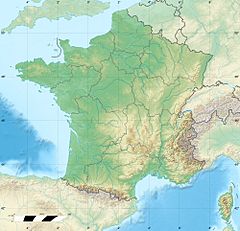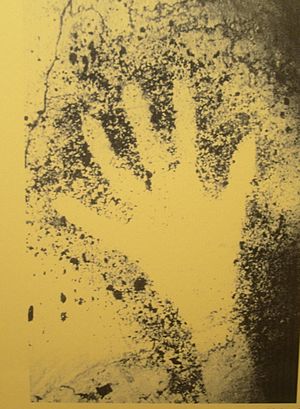Cosquer Cave facts for kids

cross section with entrance tunnel and current sea level
|
|
| Location | Calanque de Morgiou in Marseille |
|---|---|
| Region | Midi, France |
| Coordinates | 43°12′10″N 5°26′57″E / 43.20278°N 5.44917°E |
| Site notes | |
| Excavation dates | 1991 |
| Archaeologists | Henri Cosquer |
The Cosquer Cave is a famous underwater cave found near Marseille, France. Its entrance is about 37 m (121 ft) below the sea surface. This is because sea levels have risen a lot since the cave was first used by ancient people. Inside, the cave holds amazing rock art from prehistoric times.
A professional diver named Henri Cosquer discovered the underwater entrance in 1985. Divers slowly explored the long underwater passage until 1990. They didn't know at first that the cave held ancient art. It was only in 1990-1991 that divers finally reached the parts of the cave that were not underwater. The cave was named after Henri Cosquer when its discovery became public in 1991.
Exploring the Cosquer Cave
Today, divers can reach the cave through a 175 m (574 ft) long underwater tunnel. The entrance is 37 m (121 ft) deep. When people lived in this cave long ago, the sea level was much lower. During the Ice Ages, the Mediterranean seashore was many kilometers further south. The sea level was even up to 100 m (330 ft) below the cave's entrance! This means the cave was once on dry land.
How the Cave Was Found
Henri Cosquer, a diver from Cassis, found the hidden entrance to the cave in 1985. A friend had told him about it. He explored the underwater tunnel slowly, sometimes alone, sometimes with a friend. He eventually reached a narrow part that opened into an underground lake.
In 1990, Cosquer got help from two Belgian cave divers, Bernard and Marc Van Espen. They followed Cosquer's directions and found the entrance. They swam carefully to avoid stirring up the fine mud on the floor. This mud could make the water cloudy and dangerous. They reached the underground lake with an air pocket above it. But their guide line was too short, so they had to turn back. The dry parts of the cave were still a mystery.
In June 1991, Marc Van Espen returned with Henri Cosquer. They were determined to reach the end of the cave. Marc installed the last part of the guide line, which was important for safety. Their dive was short, and they only explored the first room.
A few days later, on July 9, 1991, Cosquer went back with his niece, Cendrine Cosquer, and friends Yann Gogan and Pascale Oriol. During this dive, they explored the dry parts of the cave more closely. Yann Gogan saw the outline of a hand on a wall. Pascale Oriol thought it might be a cave painting. This amazing discovery made the team want to find more. They made several more dives in July and August 1991. They found many more paintings and took photos and videos.
Sadly, on September 1, 1991, three divers got lost in the cave and died. Henri and Yann helped recover their bodies. Two days later, Henri officially reported the cave to the authorities in Marseille.
Experts, including famous prehistorians Jean Courtin and Jean Clottes, then explored the cave. They confirmed that the paintings were real and very old. At first, some people doubted if the art was truly ancient. But later missions and studies proved its authenticity.
From 2001 to 2015, many archaeological studies took place in the cave. These studies helped us learn even more about this incredible site. The French Ministry of Culture and Henri Cosquer also had discussions about the cave's ownership and how the discoverer should be recognized.
Ancient Cave Art
Sadly, about four-fifths of the cave, including much of its art, has been covered or damaged by rising seawater. But nearly 500 pieces of cave art still remain! This art comes from two different periods during the Upper Paleolithic (the late Stone Age).
- The first period was around 27,000 years ago. This art includes 65 hand stencils, which are outlines of hands. 44 of these are black, and 21 are red.
- The second period was around 19,000 years ago. The art from this time shows more detailed pictures of animals and human figures.
In total, 177 animal drawings have been found in the cave. These include:
What makes Cosquer Cave special is its pictures of marine animals. There are 16 of these, including 9 seals and 3 great auks (a type of large, flightless bird that is now extinct). There are also some jellyfish and other figures that might be fish or cetaceans (like whales or dolphins).
Among the human figures, one shows a "killed man," a scene also seen in other ancient caves like Lascaux.
See also
- List of Stone Age art
- Great auk (in cave art)




